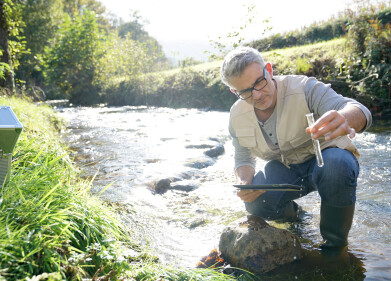Environmental Laboratory
Why Do Nitrogen and Phosphorus Matter?
Jul 03 2019
Both nitrogen and phosphorus are naturally occurring elements which are essential to not only human life, but also to the sustained growth of flora and fauna. Cognisant of this beneficial effect on growth, and of the fact that global food demand may increase by as much as 70% by 2050, the agricultural industry has taken advantage of the properties of both nitrogen and phosphorus when creating fertilisers to help crops grow.
As such, both elements are incredibly important for the agricultural industry going forward. However, an overabundance of either of them in our atmosphere could have equally impactive consequences, jeopardising the health of the surrounding environment and endangering the organisms which call that environment home. Whether through soil erosion, agricultural run-off or an industrial accident, an excess of these elements can leach into soil or water, causing grave problems for the ecosystem.
On land
The two elements act very differently in soils. While both are applied to agricultural crops as a constituent part of fertiliser, only nitrogen retains mobility once it is actually in place. This requires precision farming techniques when using either, but it does mean that there are rarely serious negative consequences of an excess of phosphorus in soil unless water becomes involved, since it has nowhere to go.
Nitrogen-rich soils, on the other hand, are a serious risk. The substance can leach into groundwater and compromise water supplies, since nitrogen is a health hazard to babies, infants and young animals due to its ability to restrict the blood’s capacity to move oxygen around the body. It can also be released into the atmosphere in the form of nitrous oxide (N2O), which is believed to be 300 times worse in terms of global warming than carbon dioxide (CO2).
In water
Perhaps the most troubling consequences of excess nitrogen are found in water. Accelerating the growth of algae and brackish plants in water, instead of the crops it was intended for, can lead to a surplus of these light-blocking organisms in rivers, streams and lakes. This prevents sunlight from reaching other grasses and plants on the floor, which act as habitats for myriad different creatures, and can cause havoc among the local ecosystem.
These algal blooms can even cause problems after their death. Once they have expired, they will sink to the floor of the river, lake or ocean and the decomposition of their remains will consume valuable oxygen dissolved in the water. This can result in significant areas of water with low oxygen concentrations, meaning that fish and other marine animals cannot survive.
Monitoring for maintenance
For the reasons listed above, ensuring that nitrogen and phosphorus levels remain at optimum concentrations at all times is essential to safeguarding the health of a wide variety of lifeforms, including humans. This can best be achieved via the use of sophisticated monitoring tools, which can determine with pinpoint precision how much nitrogen, phosphorus or other elements are present in any given substance.
The e-learning session Simple Analysis of Nitrogen and Phosphorus in Combination with TOC in Aqueous Samples is a great introduction to the topic for anyone who wishes to learn more about how concentrations of these elements can safely and easily be monitored to ensure a healthier environment for all the lifeforms which claim it as their habitat.
Digital Edition
AET 28.3 September 2024
September 2024
Business News - ENVEA announces acquisition of APAQ Group - SICK and Endress+Hauser sign strategic partnership - Efforts to curb gas flaring intensify amid environmental concerns Air Monito...
View all digital editions
Events
Nov 06 2024 Ho Chi Minh City, Vietnam
Nov 12 2024 Tel Aviv, Israel
Nov 12 2024 Valencia, Spain
Nov 12 2024 Singapore
Plastics Recycling World Expo North America
Nov 13 2024 Cleveland, OH, USA



















